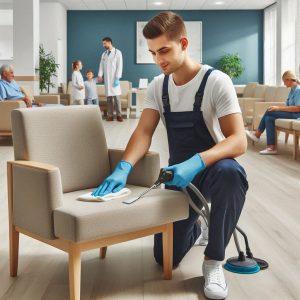 When people think of hospital cleanliness, they usually picture sparkling floors, sanitized instruments, and hands being washed nonstop. But there’s another part of the healthcare environment that often gets overlooked—upholstered furniture. Chairs in waiting rooms, padded benches in exam rooms, and staff lounge sofas are used every day by patients, visitors, and healthcare workers alike. And just like any other surface in a hospital, they need to be cleaned regularly—and safely. That’s where the best upholstery cleaners use specialized methods to ensure hygiene and fabric safety.
When people think of hospital cleanliness, they usually picture sparkling floors, sanitized instruments, and hands being washed nonstop. But there’s another part of the healthcare environment that often gets overlooked—upholstered furniture. Chairs in waiting rooms, padded benches in exam rooms, and staff lounge sofas are used every day by patients, visitors, and healthcare workers alike. And just like any other surface in a hospital, they need to be cleaned regularly—and safely. That’s where the best upholstery cleaners use specialized methods to ensure hygiene and fabric safety.
Let’s explore why safe upholstery cleaning is so important in medical facilities, how it helps with infection control, and what to know about using non-toxic cleaning methods that meet health regulations.
Upholstered Furniture: A Hidden Germ Zone
Upholstered furniture might look clean, but it can hide a lot of contaminants beneath the surface. Soft fabrics can trap:
- Dust and allergens
- Bodily fluids (like sweat, blood, or vomit)
- Bacteria and viruses
- Mold spores (especially in humid areas)
This becomes especially concerning in hospitals, where many people have weakened immune systems. Germs living in fabric can potentially spread infections or trigger allergic reactions. Regular and safe upholstery cleaning helps reduce these risks and keeps everyone—patients, visitors, and staff—safer.
Infection Control Starts with Clean Surfaces
Hospitals have strict infection control protocols, and for good reason. Healthcare-associated infections (HAIs) can have serious consequences. While most protocols focus on hard surfaces like bed rails and door handles, soft surfaces like chairs and couches shouldn’t be ignored.
Proper upholstery cleaning helps by:
- Reducing cross-contamination – Germs can transfer from clothing, hands, or spills onto furniture and back onto others sitting in the same spot.
- Eliminating bacteria and viruses – Deep cleaning helps kill or remove harmful pathogens from fabrics.
- Supporting an overall clean environment is essential for patient trust and health outcomes.
Upholstery should be included in a facility’s broader cleaning and disinfection plan.
Why Non-Toxic Methods Matter
Not all cleaning products are safe, especially in sensitive environments like hospitals. Traditional upholstery cleaners contain harsh chemicals that may leave strong odors and toxic residues or trigger respiratory issues. In a hospital setting, that’s a no-go.
Safer alternatives include:
- Green-certified upholstery cleaners – These are formulated to be non-toxic, biodegradable, and low in volatile organic compounds (VOCs).
- Steam cleaning – High-heat steam kills many bacteria and viruses without heavy chemicals.
- Encapsulation cleaning – This method uses minimal moisture and traps dirt in a polymer that can be vacuumed away once dry.
- Hospital-grade disinfectants labeled safe for soft surfaces – These products are specifically approved for use on fabric without compromising safety.
By using non-toxic and low-residue methods, hospitals can clean upholstery effectively without putting patients or staff at risk.
Meeting Health Regulations and Standards
Hospitals and medical facilities are held to high standards regarding cleanliness. Cleaning teams must follow guidelines from organizations such as:
- CDC (Centers for Disease Control and Prevention)
- EPA (Environmental Protection Agency)
- OSHA (Occupational Safety and Health Administration)
- The Joint Commission (for accredited hospitals)
While these agencies don’t all have upholstery-specific rules, they emphasize infection prevention, safe cleaning products, and routine maintenance. Upholstery care should be integrated into a facility’s environmental services (EVS) protocols, and logs should be kept to show compliance.
Upholstery Maintenance Tips for Medical Settings
Want to make sure your hospital or clinic stays on top of safe upholstery cleaning? Here are a few simple tips:
- Create a cleaning schedule – Include soft furniture in daily, weekly, and monthly cleaning checklists.
- Train cleaning staff properly. They should know how to clean different types of upholstery safely and when to use certain products.
- Use furniture designed for medical use – Look for antimicrobial or wipeable fabric options that are easier to clean.
- Spot clean immediately – Address spills and stains as soon as they happen to prevent deeper contamination.
- Document everything – Keep records of cleaning dates, products used, and any unique treatments for inspections or audits.
Clean furniture = Healthier Patients and Staff
Safe upholstery cleaning in hospitals isn’t just about appearances but health, safety, and trust. A clean, fresh-smelling waiting room or patient area conveys that a facility cares about its people and pays attention to detail.
Hospitals can protect patients’ support staff and maintain a high standard of care by using non-toxic methods, staying on top of infection control, and following health regulations. Upholstered furniture might not be the first thing you think of in a hospital—but now, you’ll never overlook it again.